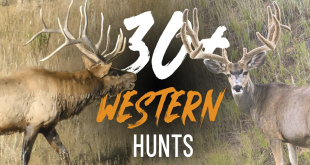
The Four-Year Area Plan Outline
With a little research and a plan, the smart hunter can hunt elk every fall regardless of whether or not they are a resident of one of the western states. The key to this is to create a plan. Such a plan revolves around three types of areas; primary areas, secondary areas and dream areas.
Primary Areas
The first thing we want to accomplish is fulfilling the need to hunt elk every year. This is where I cover all my bases and build a contingency plan, or “ringer.” Since I am a resident of Wyoming that allows me to buy an over-the-counter general elk license and hunt elk every year in my native home state. If you do not have this option however, don’t panic. You will need to pick a few states that have a decent opportunity for a trophy bull on public land with reasonable draw odds.
The first step is to list the states where odds favor getting a tag. Colorado, with its general draw, is a good place to start. Even with preference point requirements in some hunting units, this draw can provide an excellent hunt and a tag is available to the hunter that does his research at least every other year. Other states that I would recommend looking into for this type of opportunity are Wyoming, Idaho, Montana and possibly New Mexico.
The biggest mistake when researching areas is jumping to a different area each year. Picking one area and hunting it over and over is the simple secret to consistently harvesting trophy bulls.
Secondary Areas
Several states have good general elk permits for nonresidents on a draw system. For example, Wyoming is on a draw system for a nonresident general elk permit. At present, the hunter’s chance of drawing a tag is near 60 percent in the special draw. Once the hunter has compiled a list of states among his secondary areas, he needs to narrow down the areas to one per state. The idea is to put in for a tag every year, but the crucial part of the plan is to hunt the same area every time a tag is drawn. Get to know the country.
Dream Areas
Now that we have covered our bases and can be assured an elk tag somewhere out West each fall, we need to get to the nitty-gritty of our research. Now we need to pick some dream areas to apply for. This is what will determine the length of our plan and how many different states we need to apply for.
Most western states have high-profile hunting areas that produce giant bulls. These are areas where if a tag is drawn, the opportunity of harvesting a 370-plus bull is good. The drawback of these dream areas is the number of applications. Securing one of these rare tags is like winning the lottery. However, remember a hunter can’t draw a tag without putting in.
I choose to apply for dream units in Utah, Nevada and Arizona. I know that by playing the odds, I will draw a license in one of my dream areas about every three or four years between all three states.
In some states you can sit out the draw and just buy a preference point for much less than the cost of the license.
Summary
Remember to keep your plan organized, methodical and write it down. Also, keep yourself abreast and up-to-date on each state’s proclamations and regulations each year. Many states change their unit numbers and hunt dates from one year to the next. And most importantly, keep a positive attitude. You have to play the game. Each issue of the Eastmans’ Hunting Journal and Eastmans’ Bowhunting Journal is filled with stories of hunters just like you who played the game and won.
I find doing my own research results in more opportunities for a quality hunting experience. Each area has its own diversified set of conditions and terrain and it takes time to learn the movements of big game in new country because elk behavior can differ from one area to the next. Don’t be afraid to tweak a written plan when needed and don’t get discouraged while trying to learn the country, elk movements and behavior patterns. Commit to four years of hunting and scouting the same areas and stick to the plan in order to harvest trophy bulls. Remember, no trails and no hunters generally means good elk hunting.
 Eastmans' Official Blog | Mule Deer, Antelope, Elk Hunting and Bowhunting Magazine | Eastmans' Hunting Journals
Eastmans' Official Blog | Mule Deer, Antelope, Elk Hunting and Bowhunting Magazine | Eastmans' Hunting Journals




